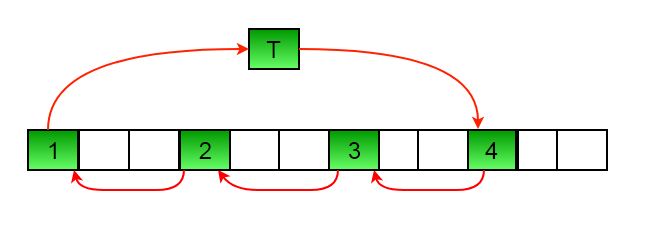Java Rotate and Translate Example
Write a function rotate(ar[], d, n) that rotates arr[] of size n by d elements.

Rotation of the above array by 2 will make array

METHOD 1 (Using temp array)
Input arr[] = [1, 2, 3, 4, 5, 6, 7], d = 2, n =7 1) Store d elements in a temp array temp[] = [1, 2] 2) Shift rest of the arr[] arr[] = [3, 4, 5, 6, 7, 6, 7] 3) Store back the d elements arr[] = [3, 4, 5, 6, 7, 1, 2]
Time complexity : O(n)
Auxiliary Space : O(d)
METHOD 2 (Rotate one by one)
leftRotate(arr[], d, n) start For i = 0 to i < d Left rotate all elements of arr[] by one end
To rotate by one, store arr[0] in a temporary variable temp, move arr[1] to arr[0], arr[2] to arr[1] …and finally temp to arr[n-1]
Let us take the same example arr[] = [1, 2, 3, 4, 5, 6, 7], d = 2
Rotate arr[] by one 2 times
We get [2, 3, 4, 5, 6, 7, 1] after first rotation and [ 3, 4, 5, 6, 7, 1, 2] after second rotation.
Java
class RotateArray
{
void leftRotate( int arr[], int d, int n)
{
int i;
for (i = 0 ; i < d; i++)
leftRotatebyOne(arr, n);
}
void leftRotatebyOne( int arr[], int n)
{
int i, temp;
temp = arr[ 0 ];
for (i = 0 ; i < n - 1 ; i++)
arr[i] = arr[i + 1 ];
arr[i] = temp;
}
void printArray( int arr[], int size)
{
int i;
for (i = 0 ; i < size; i++)
System.out.print(arr[i] + " " );
}
public static void main(String[] args)
{
RotateArray rotate = new RotateArray();
int arr[] = { 1 , 2 , 3 , 4 , 5 , 6 , 7 };
rotate.leftRotate(arr, 2 , 7 );
rotate.printArray(arr, 7 );
}
}
Output :
3 4 5 6 7 1 2
Time complexity : O(n * d)
Auxiliary Space : O(1)
METHOD 3 (A Juggling Algorithm)
This is an extension of method 2. Instead of moving one by one, divide the array in different sets
where number of sets is equal to GCD of n and d and move the elements within sets.
If GCD is 1 as is for the above example array (n = 7 and d =2), then elements will be moved within one set only, we just start with temp = arr[0] and keep moving arr[I+d] to arr[I] and finally store temp at the right place.
Here is an example for n =12 and d = 3. GCD is 3 and
Let arr[] be {1, 2, 3, 4, 5, 6, 7, 8, 9, 10, 11, 12} a) Elements are first moved in first set – (See below diagram for this movement)  arr[] after this step --> { 4 2 3 7 5 6 10 8 9 1 11 12} b) Then in second set. arr[] after this step --> {4 5 3 7 8 6 10 11 9 1 2 12} c) Finally in third set. arr[] after this step --> {4 5 6 7 8 9 10 11 12 1 2 3 }
arr[] after this step --> { 4 2 3 7 5 6 10 8 9 1 11 12} b) Then in second set. arr[] after this step --> {4 5 3 7 8 6 10 11 9 1 2 12} c) Finally in third set. arr[] after this step --> {4 5 6 7 8 9 10 11 12 1 2 3 } Java
class RotateArray
{
void leftRotate( int arr[], int d, int n)
{
int i, j, k, temp;
for (i = 0 ; i < gcd(d, n); i++)
{
temp = arr[i];
j = i;
while ( true )
{
k = j + d;
if (k >= n)
k = k - n;
if (k == i)
break ;
arr[j] = arr[k];
j = k;
}
arr[j] = temp;
}
}
void printArray( int arr[], int size)
{
int i;
for (i = 0 ; i < size; i++)
System.out.print(arr[i] + " " );
}
int gcd( int a, int b)
{
if (b == 0 )
return a;
else
return gcd(b, a % b);
}
public static void main(String[] args) {
RotateArray rotate = new RotateArray();
int arr[] = { 1 , 2 , 3 , 4 , 5 , 6 , 7 };
rotate.leftRotate(arr, 2 , 7 );
rotate.printArray(arr, 7 );
}
}
Output :
3 4 5 6 7 1 2
Time complexity : O(n)
Auxiliary Space : O(1)
Please refer complete article on Program for array rotation for more details!
Source: https://www.geeksforgeeks.org/java-program-for-array-rotation/
0 Response to "Java Rotate and Translate Example"
Postar um comentário